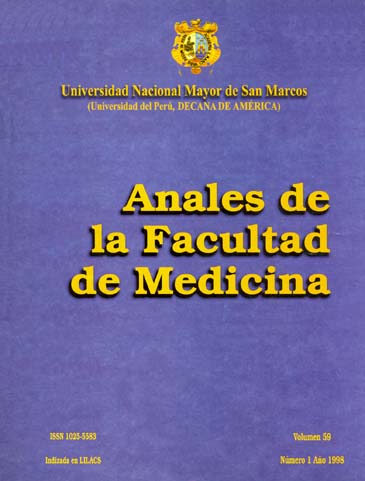Arm Anthropometric Ratios in peruvian schoolchildren
DOI:
https://doi.org/10.15381/anales.v59i1.4643Keywords:
Nutritional status, arm circunference, nutrition assessment, skinfold thickness, anthropometry, child nutritionAbstract
We have studied the nutritional status of schoolchildren by arm anthropometric ratios. 1 525 children between 6 - 9 years of age were studied. The data is a representative sample of Peru, and belongs to the Survey of Nutritional Status of the Peruvian Inhabitant (Estado Nutricional del Poblador Peruano «ENPPE»). The ratios are Arm Circumference (AC) and Triceps Skinfold (TS) related with age. With AC and TS, Arm Muscle Area (AMA) and Arm Fat Area (AFA) were calculated. Measures were taken following the recommended international methodology. The reference sample used was the Frisancho´s one. About 44% and 23% of children have an AC and TS smaller than 10p, respectively. In both ratios the prevalence of children over 90p does not exceed 3%. For AFA, 32,6% of girls and 25,9% of boys are below 10th; for AMA, male have the largest prevalence (32,3%; female 27,7%). Prevalence over 90p does not exceed 2%. AC and TS average for different ages rank between 10 and 25p and about 25p from reference sample, respectively. 16,3 and 3,2% of children are over 85p of body mass index and TS (obesity), respectively. Only 1,8% of children ranks over 85p for both ratios. AC, TS, AMA and AFA are nutritional storage ratios, which shows a sharp detriment of magre and fatty mass in a great number of children.Downloads
Published
1998-03-16
Issue
Section
Trabajos originales
License
Copyright (c) 1998 Jaime Pajuelo Ramírez, Isabel Amemiya

This work is licensed under a Creative Commons Attribution-NonCommercial-ShareAlike 4.0 International License.
Those authors who have publications with this magazine accept the following terms:
- Authors will retain their copyrights and guarantee the journal the right of first publication of their work, which will be simultaneously subject to Creative Commons Attribution License that allows third parties to share the work as long as its author and its first publication this magazine are indicated.
- Authors may adopt other non-exclusive licensing agreements for the distribution of the version of the published work (eg, deposit it in an institutional electronic file or publish it in a monographic volume) provided that the initial publication in this magazine is indicated.
- Authors are allowed and recommended to disseminate their work over the Internet (eg: in institutional telematic archives or on their website) before and during the submission process, which It can produce interesting exchanges and increase quotes from the published work. (See El efecto del acceso abierto ).
How to Cite
1.
Pajuelo Ramírez J, Amemiya I. Arm Anthropometric Ratios in peruvian schoolchildren. An Fac med [Internet]. 1998 Mar. 16 [cited 2024 Jul. 17];59(1):23-8. Available from: https://revistasinvestigacion.unmsm.edu.pe/index.php/anales/article/view/4643















